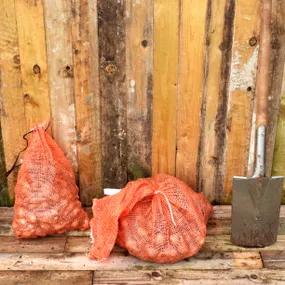'King Alfred' Daffodil Bulbs
The details
- Group 1: Trumpet Daffodil
- Colour: Two tone pale/yellow
- Height: 45cm
- Scent: Light
- Flowering: March
- Planting Depth: 10-15 cm
- Planting Months: September - November
Recommended extras
Description
King Alfred Daffodil Bulbs
King Alfred (Narcissus 'King Alfred') daffodils are everybody's friend. They have classic bright golden flowers, with open, frilled trumpets heralding the return of spring through gardens and out only roadside verges and under hedges.
Alone, or in our Naturalising Mix, King Alfred, which holds the RHS Award of Garden merit, is a super daffodil for creating large drifts in lawns, borders, wooded areas or containers. With a pedigree of over 100 years this charming yellow flowering bulb is sure to delight gardeners. See the full range of narcissus and daffodil bulbs we have available for sale.
- Group 1: Trumpet Daffodil
- Height 40-60cm
- Spread 10-15cm
- Single heads
- Mid-green leaves
- Lightly scented
- 2-5 years to mature
Plant Care
Plant bulbs in autumn (August-November) at about twice their own depth, in full sun or partial shade. They can be planted in clumps, for a more natural look but avoid planting very closely or you may inhibit flowering. Keep the bulbs around 10cm apart for best results. They do multiply underground so the gaps will soon fill in.
They prefer well-drained soils and full sun (flowers will tend to face into the sunshine) but are very adaptable and will tolerate most situations apart from boggy, wet soils and shade.
You can carry out deadheading when the flowers are finished, but they will grow better in subsequent years if you allow the leaves to die back fully before cutting them.
For container or indoor planting, put the bulbs in pots at a depth of around 5cm in a loam-based compost in early autumn. They can stay outdoors in a cold frame until shoots appear, then grow on in a greenhouse. As soon as the buds begin to open you can bring them indoors.
Look out for...
The main enemy of daffodils is waterlogged ground. They can also be attacked by slugs as well as the more obscure problems of Narcissus yellow stripe virus, large narcissus fly and various kinds of eelworm.
Daffodil sap is poisonous and can irritate skin, so handle all Narcissus with care. Thinning out clumps as they spread over the years will help maintain a dramatic display.
Did you know...
Narcissus 'King Alfred' was developed by a group of market gardeners in the 1890s, in the small Devon village of Newton Poppleford. A thousand years earlier this was in the region then known as Wessex, and the flower is named in honour of the former King of Wessex, to commemorate him 1,000 years after his death.
A solicitor from London, John Kendall, had a house in the village (and a great enthusiasm for daffodils) and was credited with breeding this daffodil, but in fact, much of its development can truthfully be attributed to the local gardener Walter Hill. Hill worked for John Kendall's son Percy, himself the owner of a market garden and a florist in the area.
Between them these men had developed a hybrid that took the Royal Horticultural Society by storm: at its first presentation it won a First Class Certificate for being "by far the best large yellow trumpet." John Kendall sadly had died before this moment of triumph came.
His son Percy died some years later and the business was taken on by Walter Hill who was eventually shipping great quantities of the flower to London's Covent Garden flower market every morning in spring.
King Alfred has gone on to become the progenitor of many other yellow trumpet varieties, (up to 90% of them according to some) and there are many descendants going under the same name.

 Hero Img.webp)
 Hero Img.webp)
 Img 2.webp)
 Img 3.webp)
